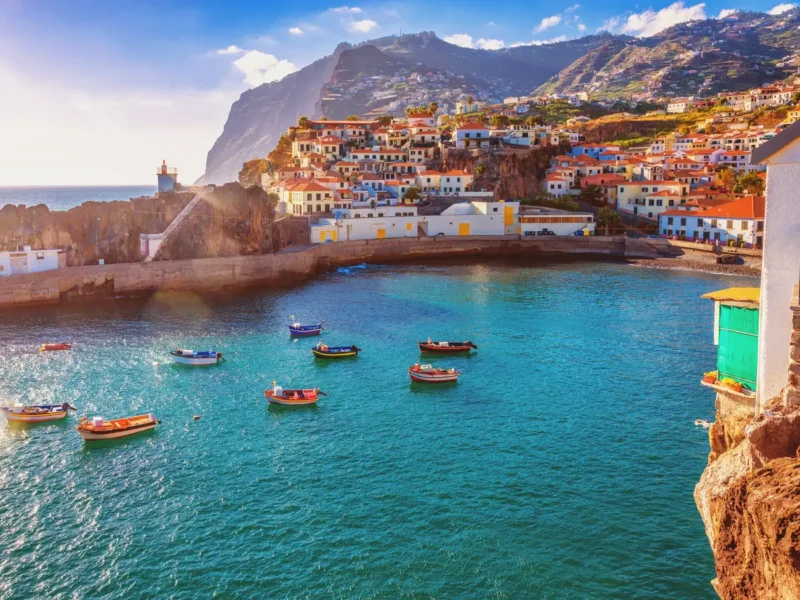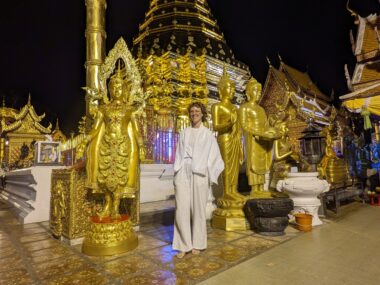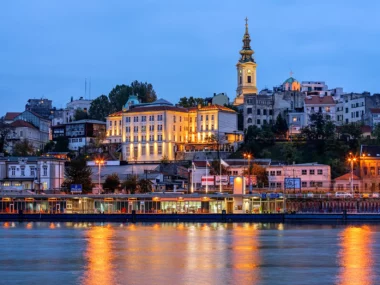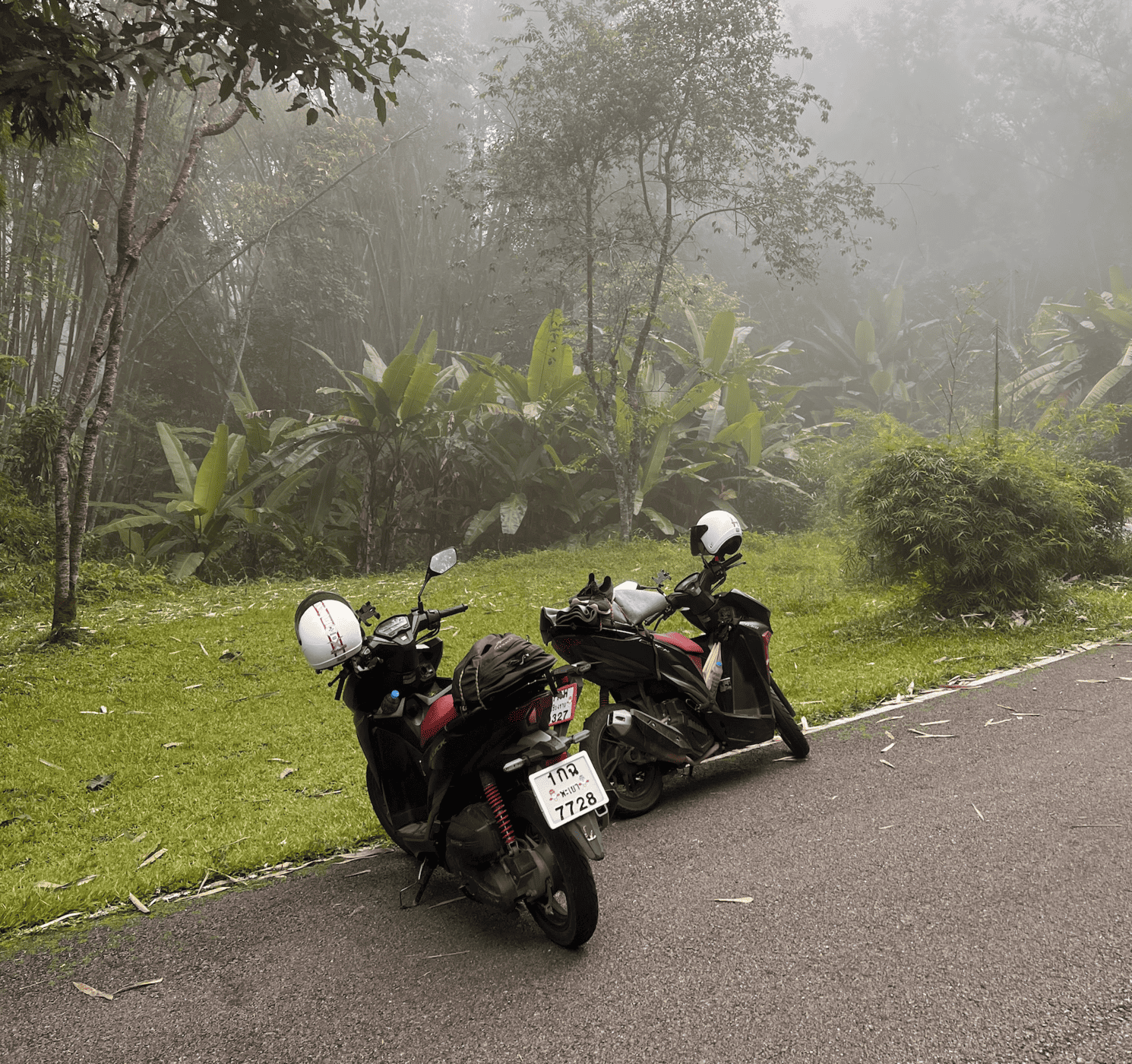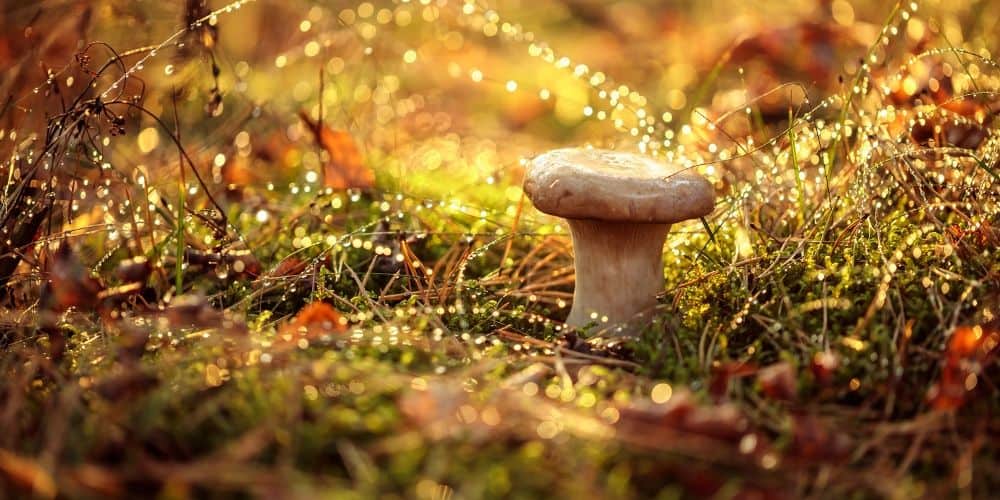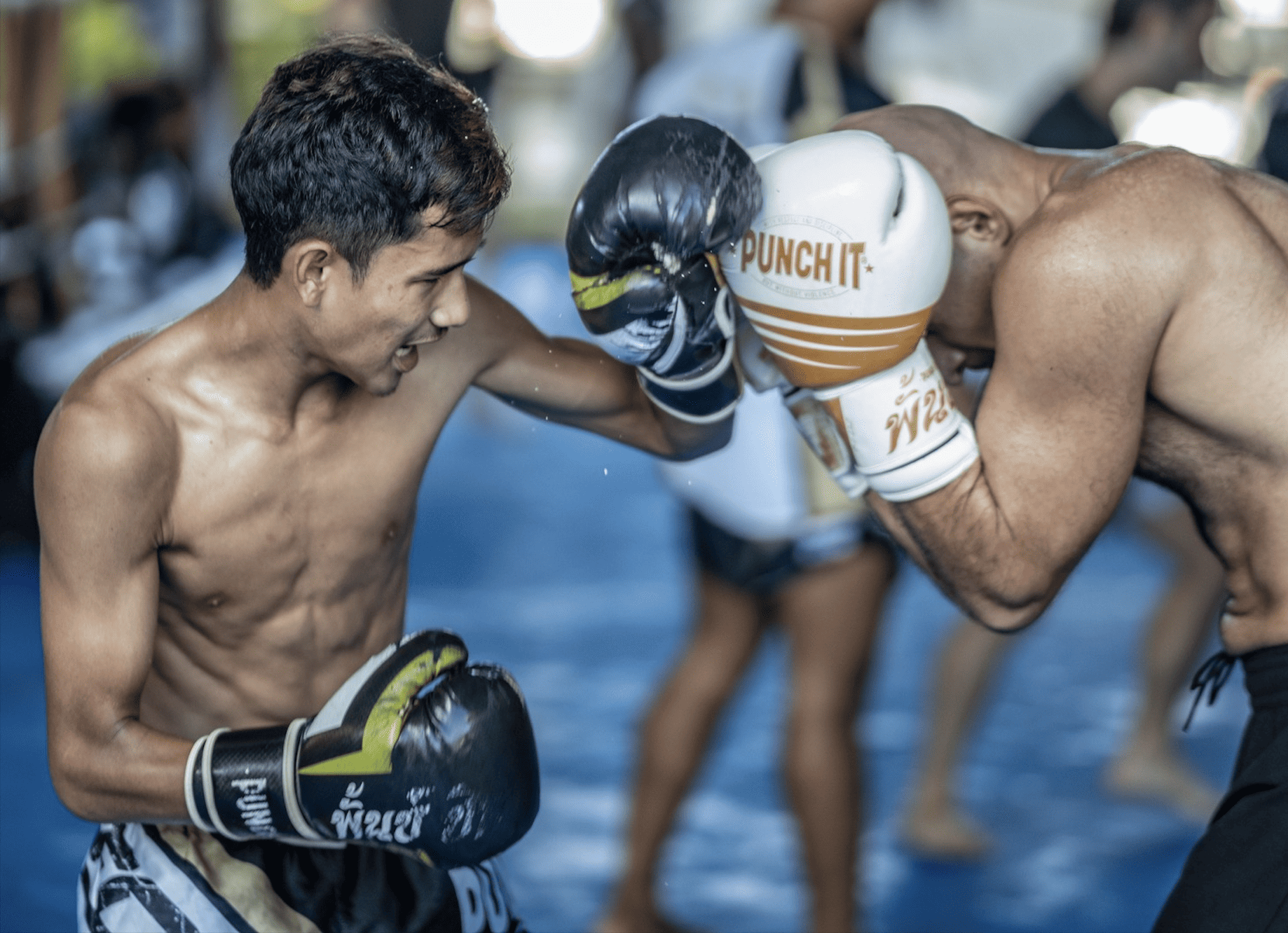Table of Contents
Planning a trip on a budget isn’t always easy. My partner and I wanted to celebrate his 27th somewhere special, but flight prices were making us rethink our plans. We’ve always wanted to see Portugal, hearing so much about it from friends. With only a couple hundred in the bank account It’s a little bit harder for us Canadians. But after a whole lot of searching we struck gold and found YYZdeals.com. That’s when everything changed.
We snagged round-trip flights to Portugal for just $580 CAD. Without wasting any time, we booked the tickets, packed our bags, and got ready for an adventure. Our overnight flight to Lisbon was filled with excitement, and we couldn’t wait to see what this beautiful country had in store for us.
Landing in Lisbon early, we had a full day ahead to kick off Aaron’s birthday. We were excited to explore the cities, enjoy the food, and soak up the culture. Our trip to Portugal was all about making the most of every moment and discovering new places together.
Discovering Lisbon
Lisbon, the capital of Portugal, is a city where history meets modern life in the best way. It’s one of the oldest cities in Europe, with roots going back to the Phoenicians. They have beautiful and ancient streets like Alfama, with its maze-like alleys, or even Baixa, the downtown area that was rebuilt after a massive earthquake in 1755. Some must see spots include the Belém Tower and São Jorge Castle. Don’t miss out on a pastel de nata at a local café.
Day 1
Landing in Lisbon, Portugal
When we landed in Lisbon, the city’s energy hit us immediately, even though the weather was a bit gloomy. Fresh off the plane and hungry, we headed straight to Time Out Market. This place came highly recommended by friends and travel blogs.
Time Out Market
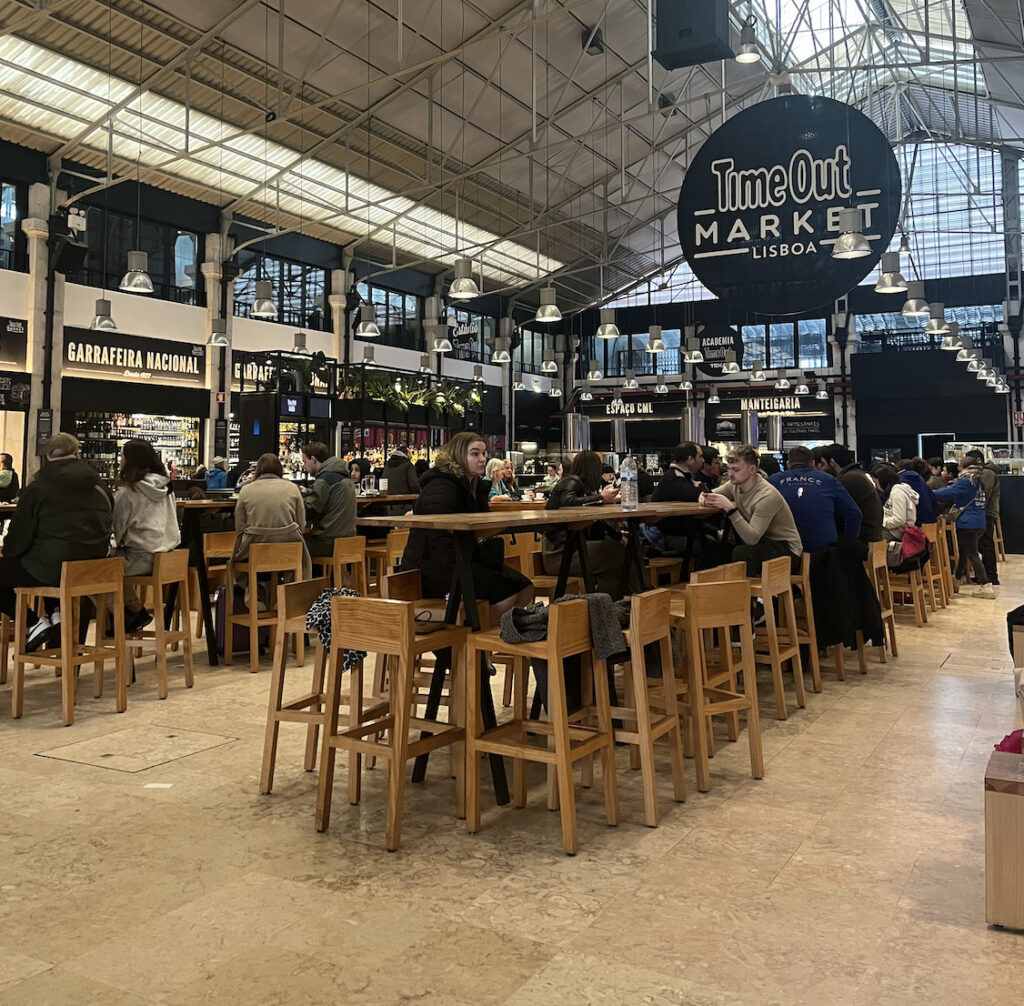
Time Out Market is a foodie’s paradise, bringing together some of Lisbon’s best eats under one roof. We started our day with breakfast at Tartine. The BLT with eggs and toast had a tangy kick we weren’t used to, but it was delicious. The biggest surprise? People drinking wine with their breakfast. It was a real “we’re not in Kansas anymore” moment and gave us a taste of the laid-back European lifestyle.
Checking into the Hostel
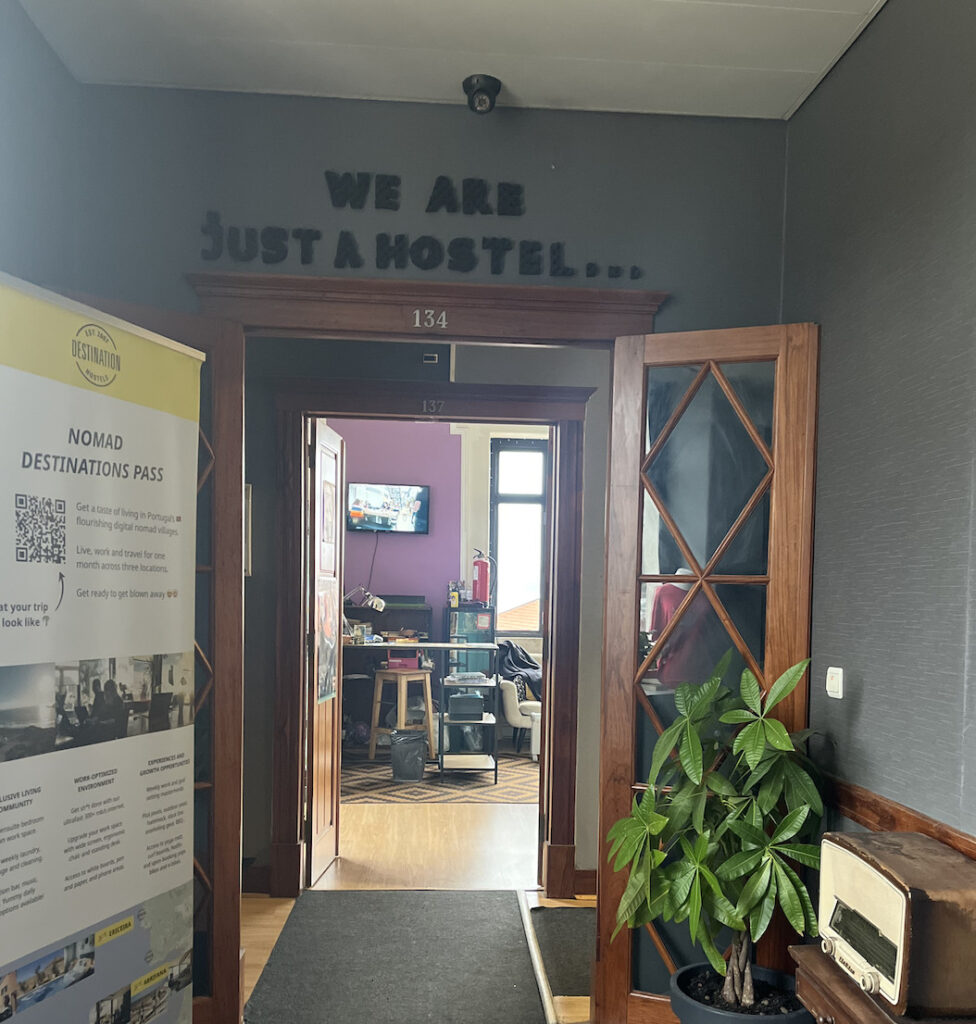
We checked into Sunset Destination Hostel, marking our first experience with hostel living. The rain was cold, but the welcome was warm. Aaron was new to sharing a room with strangers, but with an open mind anything is possible. I had some old college dorm experiences to fall back on, which helped. The communal aspect brought unexpected connections and tips about the city. It was clear that the people we met would be a huge help to us in figuring out what we were going to explore.
Oceanário de Lisboa

With the weather still being unpredictable, we decided to explore indoors and headed to the Oceanário de Lisboa. Pro tip: book your tickets online to skip the line. This massive aquarium is one of the largest in Europe and focuses on marine conservation. From penguins and tropical fish to rays and jellyfish, the exhibits were incredible. The central tank is massive and made us feel like we were on the ocean floor it was filled with sharks and barracudas. Although it was an unexpected visit, we were still glad we went. We ended up spending a couple hours here and checked out the mall beside it and got some European gelato!
Vasco da Gama Bridge

In the evening the sun peeked out, so we took the cable cars near the aquarium. The view of the Vasco da Gama Bridge, the longest bridge in Europe, was incredible. Opened in 1998, the cable car spans 17.2 kilometers and connects Lisbon to the Alcochete region. Named after the explorer Vasco da Gama, the bridge symbolizes Lisbon’s blend of history and modernity.
Our first day in Lisbon was packed with new experiences and a blend of the city’s historical and modern vibes. We couldn’t wait to see what the rest of our trip had in store.
We headed back after grabbing a quick slice of pizza at a corner store at our hostel and decided to call it a night. Tired from the flight, we decided the next day would be packed with more energy and fun.
Day 2
Exploring Sintra
We started off Monday (our first official day) with an early trip to Sintra. The weather was chilly but sunny, and the fog on our drive up to Pena Palace added a super mysterious vibe. Our tour guide was this 20-year-old guy who had so much knowledge about Sintra even though he wasn’t even from Portugal! He shared some really cool insights. We also met some travelers from Germany who were on the trip with us, which was fun.
Pena Palace

Pena Palace was our first stop. Sitting high in the Sintra Mountains, we learned that this is a 19th-century castle known for its beautiful colors and mix of architectural styles. The castle itself, a bright yellow, was built on the ruins of a monastery destroyed by the Great Lisbon Earthquake of 1755. We learned all about King Ferdinand II and how he transformed it into this unique, fairy-tale-like palace.
We spent hours wandering through its foggy gardens, filled with swans and secret pathways. We got a chance to explore the narrow, web-filled tunnels, which were once used to transport water. We tried squeezing in there for a better look, but it was so narrow, I have no idea how people used to fit in there!
Sintra Historical Centre
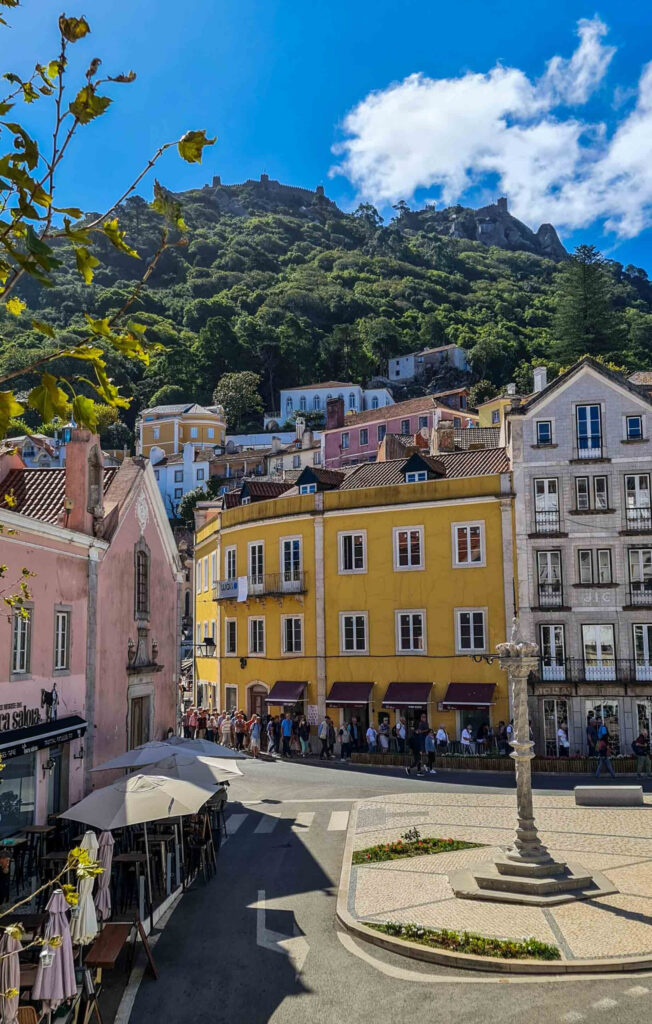
Next, we headed to the center of Sintra, a UNESCO World Heritage site. The town itself is famous for its 19th-century architecture and gorgeous landscapes. We explored some tiny bookstores and cafes, we obviously had to get some pastel de nata while we relaxed and people-watched.
Fun fact: Pastel de nata was invented by monks at the Jerónimos Monastery in the 18th century. It quickly became a favorite of mine. We also sampled some other local pastries like Travesseiro and Queijada ( I had a lot of pastries on this trip).
Cabo da Roca

After spending around an hour or so exploring the center of Sintra, we continued to Cabo da Roca, which is also known as the westernmost point of Europe. This was one of the most breathtaking views I’ve ever seen. You can see the waves from the Atlantic Ocean crashing against the high cliffs.
We also learned on our way over that during the Age of Exploration, Cabo da Roca was one of the most important navigational points and was often considered the end of the world. To really soak in the views we trekked across the rocks to find the best spot on the cliffs and spent some time just staring out into the ocean.
Cascais
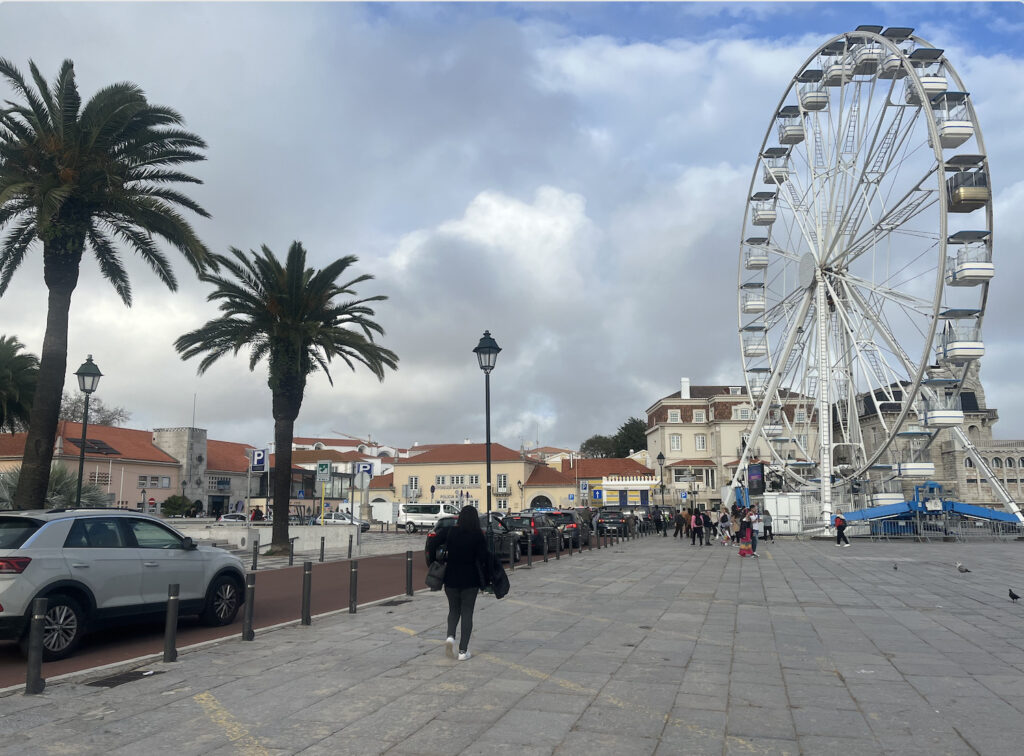
Our final stop on this Sintra tour was Cascais, this place is also known as the Portuguese Riviera. This coastal town, was once a royal retreat, is full of beautiful beaches and mansions. During World War II, Cascais was a hotspot for spies and exiled royalty. With Portugal’s neutral status during the war, Cascais became a refuge for those seeking safety from the conflict.
The town was home to several European royal families, including ones from Spain and Italy. It was also rumored that it was a gathering spot for spies from both the Allies and Axis powers, adding a little more mystery to the place. We walked through a small fishing community and saw where the Portuguese Royal Family once stayed. The mix of small town vibes and rich history was really interesting to see.
Back to Lisbon
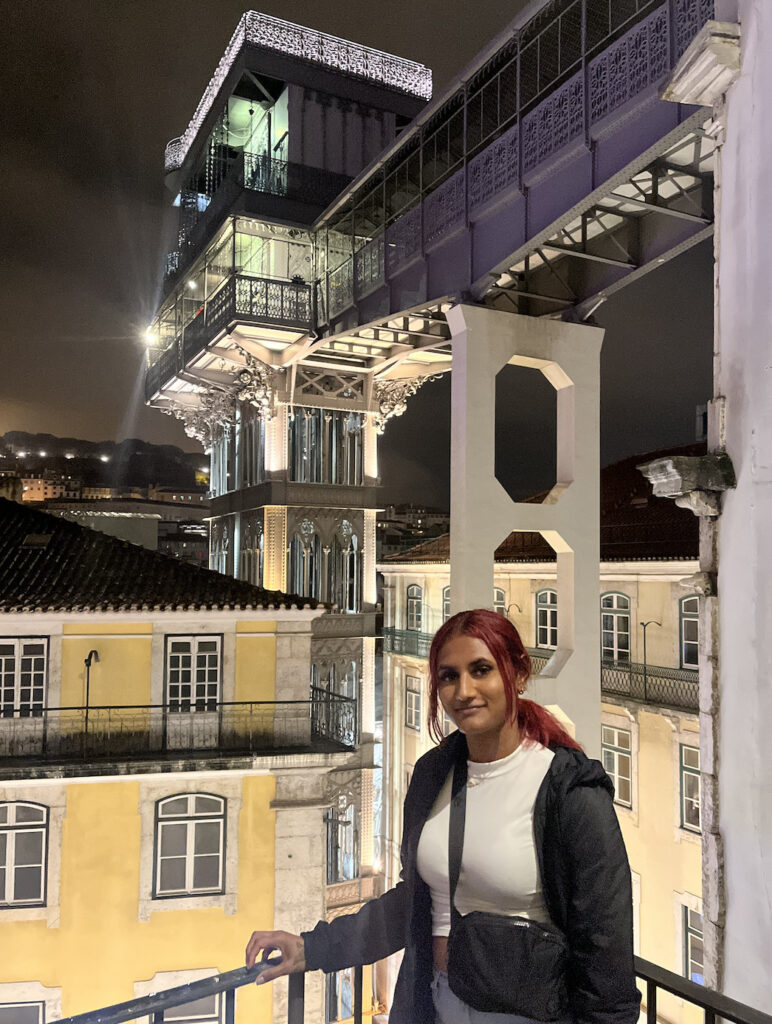
After returning to Lisbon, we decided to visit the Elevador de Santa Justa. This was one of the spots that we were told was a must visit. The elevator was built in the early 1900s, and was designed by Raul Mesnier de Ponsard, who happened to be a student of Gustave Eiffel (a famous French Civil Engineer). Even though it was pouring rain, we waited in line for over an hour. The views were okay, but it felt a bit too touristy. If you’re not into crowded spots, I’d suggest skipping it.
Pink Street
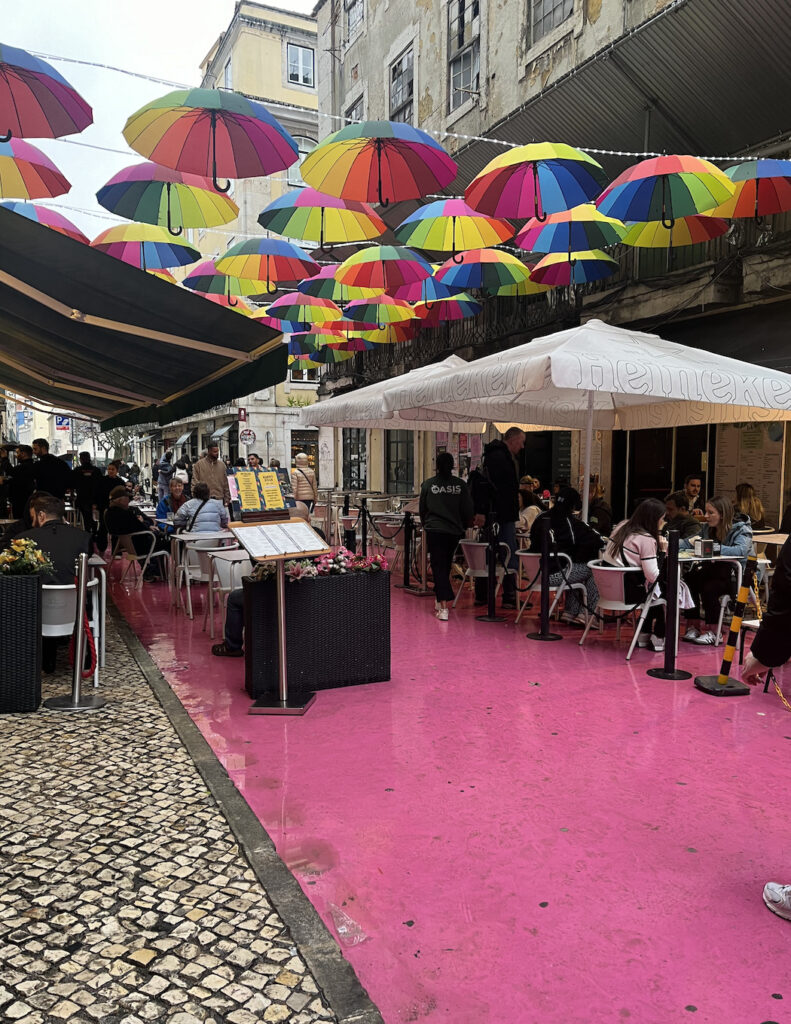
We spent the rest of the day walking around Lisbon, checking out the different types of buildings. It was still a bit rainy, and I quickly realized that everything in Lisbon is uphill! It was a bit chaotic, and I was exhausted. Every time I saw another set of stairs, I wanted to cry, haha. But then we finally got to Pink Street.
Pink Street is one of those places everyone talks about, but it felt a bit underwhelming when we got there. Maybe it was just the weather, but it didn’t seem as loud and fun as the photos. Still, it was cool to see all the decorations up. There were little umbrellas attached to string lights covering the street. We didn’t stay long, but I’d love to come back in the summer when it’s more lively and full of people.
Fabbrica di Pasta Fresca – Chiado

On our way back to the hostel we got pretty hungry, and stumbled across Fabbrica di Pasta Fresca in Chidao while walking around and decided to give it a try. It turned out to be one of the most beautiful Italian restaurants I’ve been to, and the food was amazing. The arancini balls were the best I’ve ever had, and the four cheese pasta was to die for. They make all their pasta in-house, and everything is made fresh to order. It had an upscale ambiance with high-quality food. I’d definitely recommend it.
Discovering Madeira
Madeira is a stunning island off the coast of Portugal that feels like a tropical paradise.It’s known for its landscapes and warm weather, it’s also called the “Hawaii of Europe.” The island’s massive cliffs, beautiful beaches, and thick forests make it perfect for outdoor activities. In Funchal, the island’s capital, you can explore markets like Mercado dos Lavradores, visit the famous Cristiano Ronaldo Museum, or just take a walk through the charming old town. Don’t miss out on the insane views from the Cabo Girão Skywalk or the experience of riding a cable car up to Monte. Whether you’re hiking through the levadas, relaxing in a seaside café, or sampling the local Madeira wine, this island has something for everyone.
Day 2
Flight to Madeira, Portugal
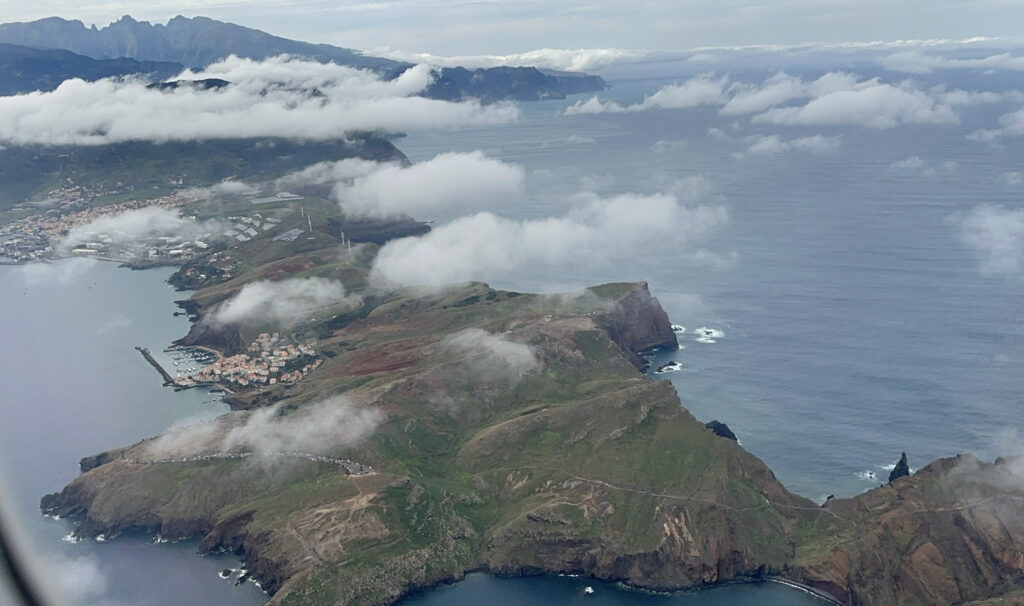
After a quick two days in Lisbon, we hopped on a flight to Madeira! So many friends recommended this place so we just had to see it for ourselves. Our tour guide in Sintra had mentioned that Madeira has tropical weather and gorgeous beaches, and he was spot on. The flight into Madeira is a bit tricky—from what I heard only specially trained pilots can land there because it’s so windy and challenging. But the short hour-and-a-half flight was smooth, and landing in warm, 25°C weather was a needed change from the chilly Lisbon temp.
Quick tip: if you’re getting around Madeira, download Bolt. It’s like their version of Uber or Lyft, and taxis are pretty rare. Public transport is common, but if you’re not renting a car, Bolt is a lifesaver. We got lucky finding cars available, but it can be hit or miss.
Cabo Girão Skywalk
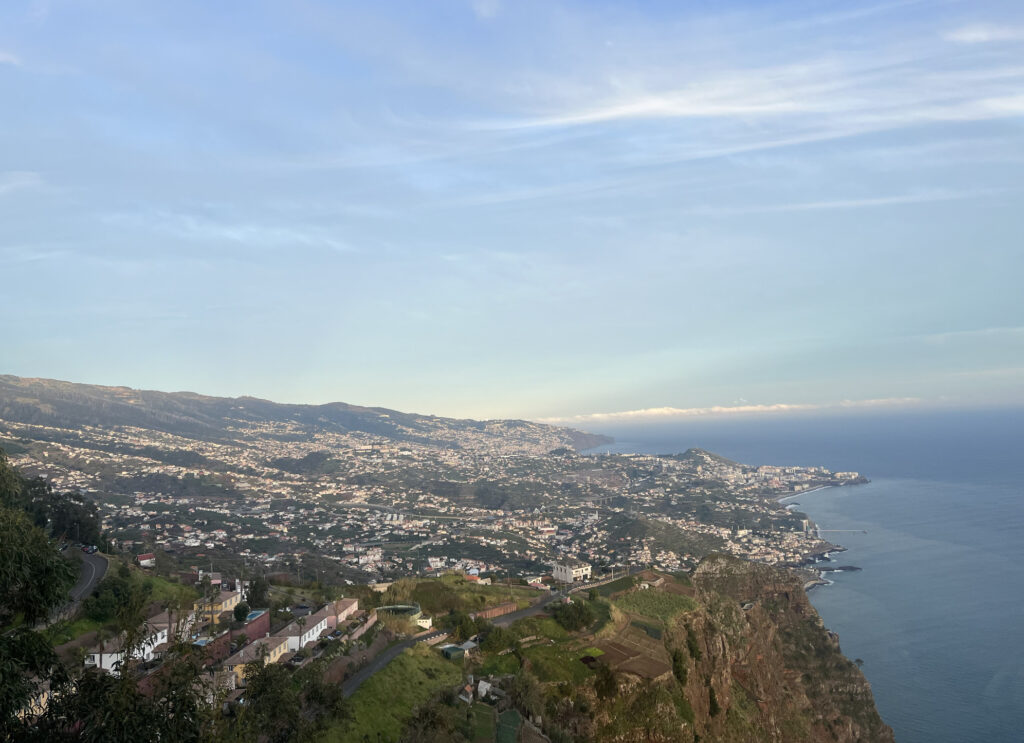
We stayed in Funchal, Madeira’s main city. One of the first things we did was head to the Cabo Girão skywalk. This spot is the highest cliff skywalk in Europe, sitting at 580 meters above sea level, and gives you insane ocean views. The glass floor adds an extra thrill to the experience. I was terrified but still did it, we were insanely high up. But it was all worth it when we got to see the stunning sunset; it’s definitely something you shouldn’t miss if you’re in Madeira.
Funchal Cathedral

After the sunset we decided to check out the Funchal Cathedral. This place has some cool history—it was built in the early 1500s and features a unique wooden ceiling made from local Madeira wood. The cathedral’s Gothic style combined with Manueline influences makes it stand out. The mix of whitewashed walls and dark volcanic stone details gives it a really unique look. Inside, it’s full of intricate carvings and has a big and beautiful altarpiece that is pretty impressive.
Mercado dos Lavradores

On our way back from the Cathedral, we also wandered through the Mercado dos Lavradores, Funchal’s traditional market. Opened in 1940, it’s a place with tons of fresh produce, flowers, and local goods. You have to try the passion fruit and anona there. Even just the market’s architecture is also worth the trip, with beautiful azulejos (blue and white tiles) showing the regional scenes and adding to the small town charm.
Azulejos
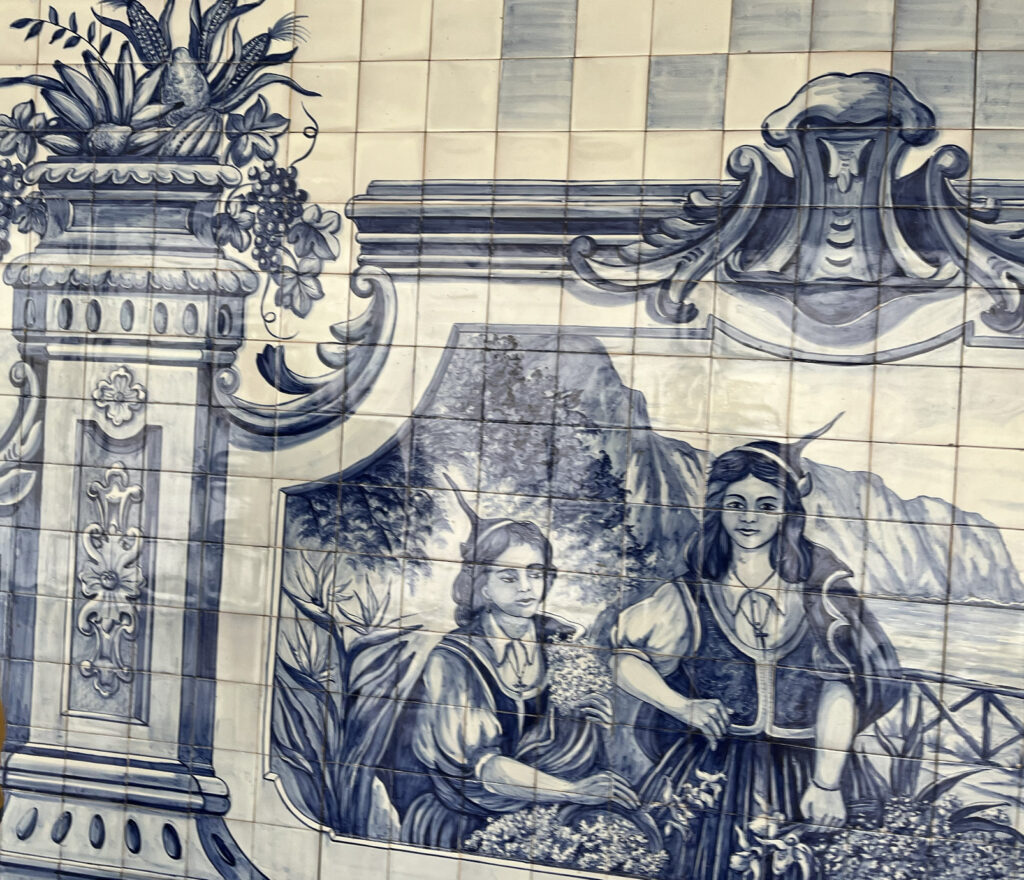
Speaking of azulejos, these blue and white tiles are iconic in Portugal. They’ve been around since the 15th century and can be found on buildings all over the country, showing off historical and cultural scenes. This style was originally introduced by the Moors, who were the Muslim people of North Africa and the Iberian Peninsula who migrated to Portugal during the Middle Ages. Since then these tiles have become an important part of Portuguese culture and art.
Dinner at Asian Flavors
We ate dinner at a spot we found on google maps called Asian Flavors. We were craving Chinese food and it was a bit of a letdown. The service was terrible, our food took forever, and when it finally arrived, it was cold. The staff was rude, and the tables were so cramped that it felt claustrophobic. Not a place I’d recommend.
Despite the dinner drama, our day in Madeira was awesome. The island’s views and culture totally made up for it, and we couldn’t wait to see what was next.
Day 3
Cristiano Ronaldo Museum

We woke up on Wednesday and started the day off with an early morning walk along Funchal’s coastline. Our hotel was right by the water, so it was super easy to get out and enjoy the ocean views. After our relaxing walk, we headed to the Cristiano Ronaldo Museum, or “CR7 Museum.” Since Madeira is Ronaldo’s birthplace, it was a must-see. The museum, opened by Ronaldo himself in 2013, is small but packed with cool stuff about his life and career, including over 125 trophies and countless memorabilia. It’s right in the Sé district of Funchal, a great area to wander around.

After the museum, we found a cozy local spot for lunch and tried some traditional Madeiran dishes like bolo do caco (Madeiran garlic bread), espetada (beef skewers grilled on a bay laurel stick), and milho frito (fried cornmeal cubes). The food were incredible and gave us a true taste of the culture.
Nuns Valley (Curral das Freiras)
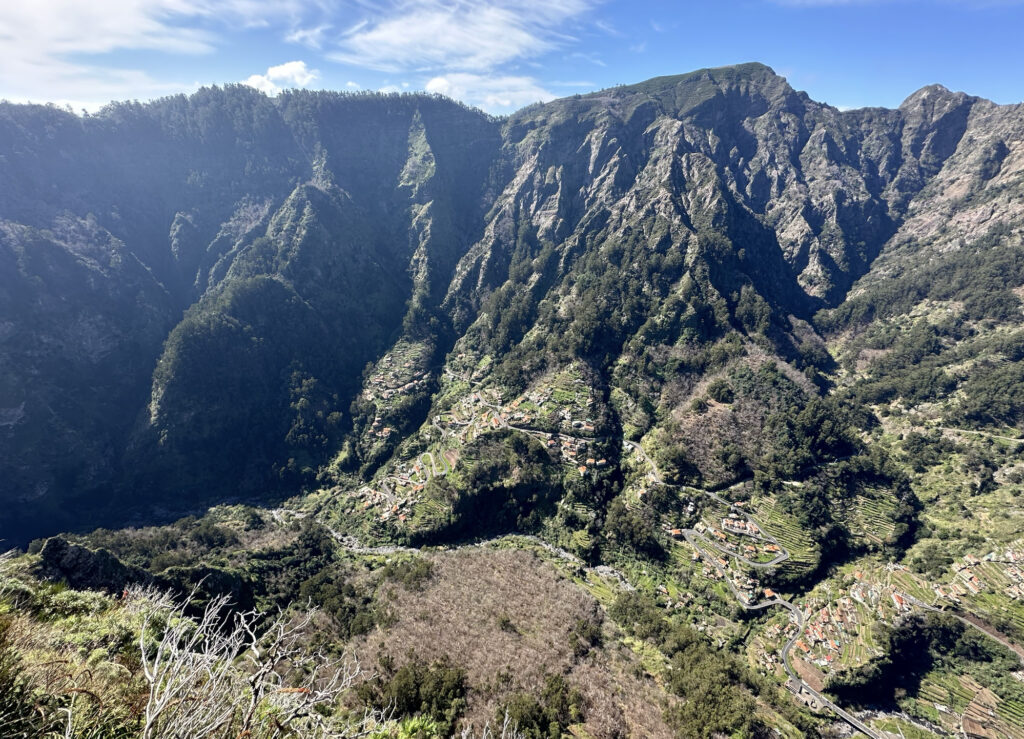
Next, we headed to Nuns Valley, or Curral das Freiras. This village is literally located at the bottom of a deep valley surrounded by steep mountains. The reason it’s called Nuns Valley is because the nuns who founded it were escaping pirate attacks in the 16th century and found refuge here because of its remote location. The views from the top were mind-blowing—over 1,000 meters above sea level, you can see the entire dramatic landscape– and I mean DRAMATIC.
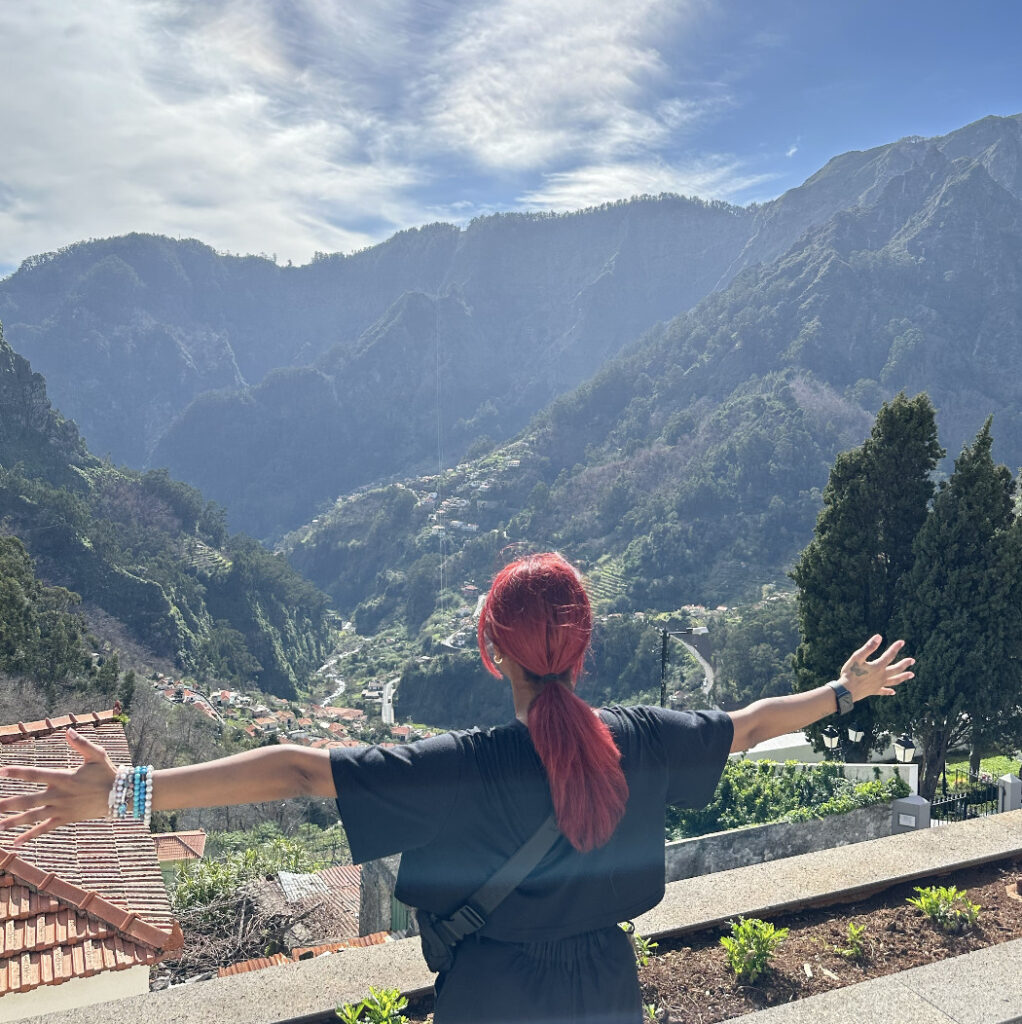
Câmara de Lobos – Fisherman’s District

After taking in the views, we drove down to Câmara de Lobos, a charming little fishing town we saw from the viewpoint. Winston Churchill loved this place and used to paint its scenic harbor. The town’s name, which means “Chamber of the Sea Lions,” comes from the monk seals (also known as sea lions) that used to lived in the area. We tried some local chestnut cake, which is super popular in Madeira.
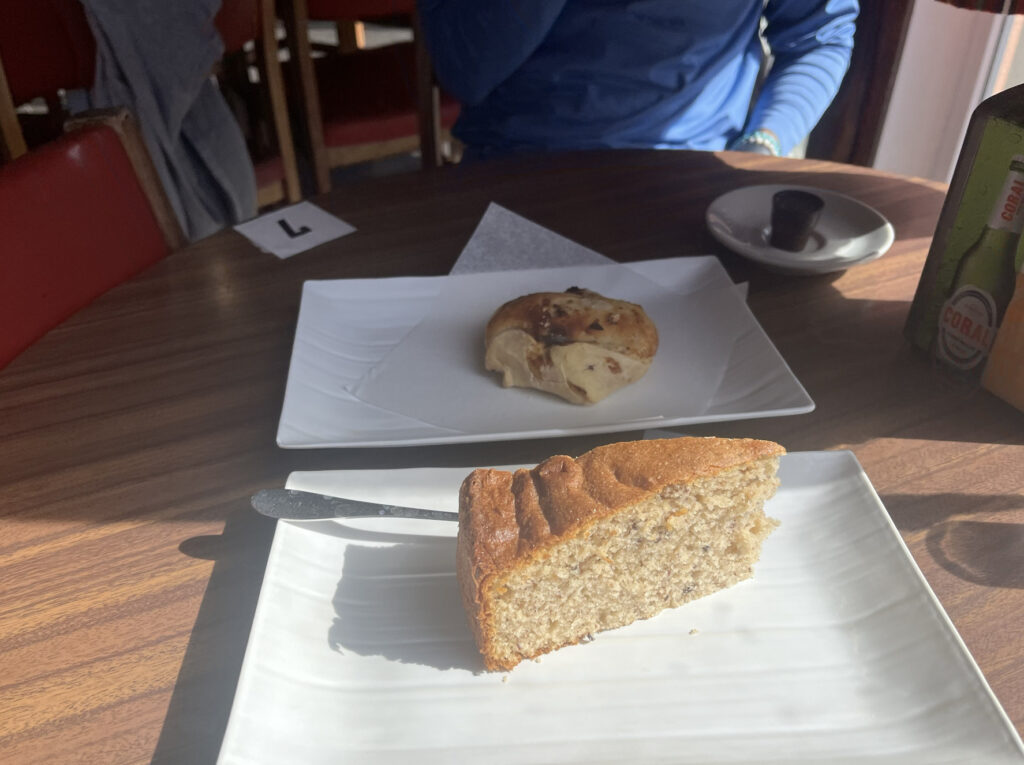
We also tried their chesnut cake, made from ground chestnuts. It was honestly so much better than I had anticipated since I’m not a huge fan of nuts. The village is known for its chestnuts, and every year they host a chestnut festival where you can taste chestnut soup, liqueur, and cake. It’s easily one of the most beautiful places I’ve ever been.

The town is also very well known for its traditional fishing boats called “xavelhas,” which are painted in these bright colors which added so much more life to the town.
Beaches and Surfing
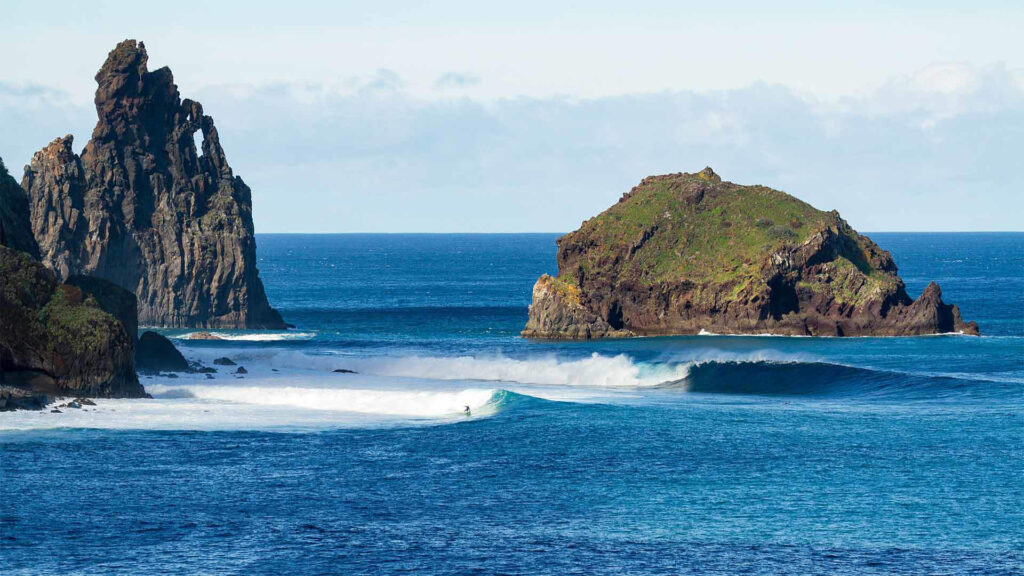
Madeira is also known for its beautiful beaches and great surfing spots. On our drive back to Funchal, we saw some surfers tackling huge waves during a competition. Madeira’s coastline and strong Atlantic waves make it a hot spot for surfing, especially in areas like Jardim do Mar and Paul do Mar. It was really cool to watch them in action and added an unexpected highlight to our day.
Pico do Arieiro
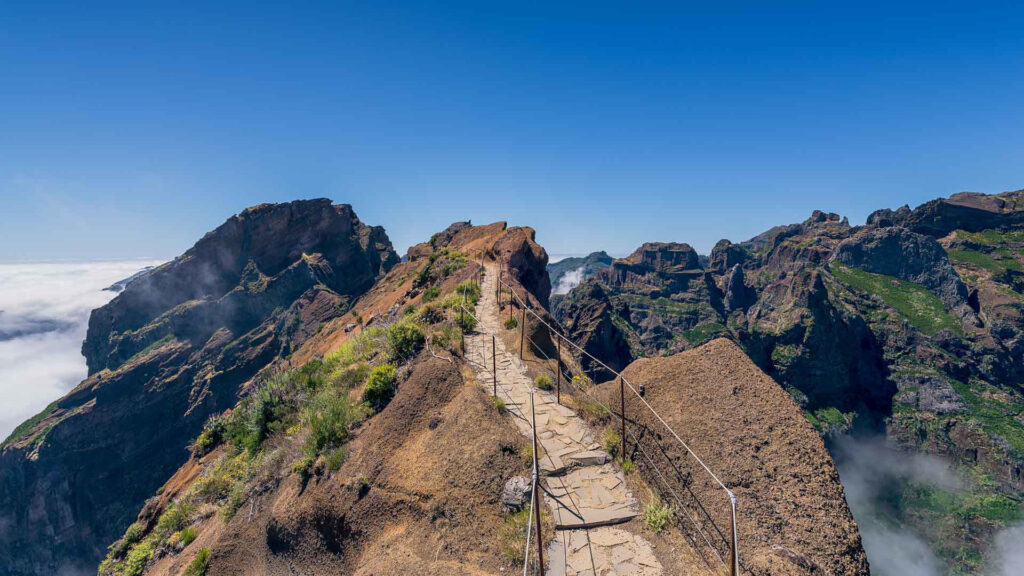
We finished our day trip with a visit to Pico do Arieiro, which is one of Madeira’s highest peaks at 1,818 meters. The drive up was full of (scary) winding roads and gorgeous scenery. When we made it to the top, the views were incredible, we were above the clouds! On clear days, you can see all the way to Pico Ruivo, which is the island’s highest point. Pico do Arieiro is also a great hiking spot, with trails that wind through the mountain.
We didn’t have time to go on a hike, but I’d love to come back to try it out. One of the popular trails here is the hike from Pico do Arieiro to Pico Ruivo, which has breathtaking views but is known to be really difficult, almost a 5 hour hike. A cool fact about this place is that during World War II, it was used as a strategic lookout point.
Monte Cable Car
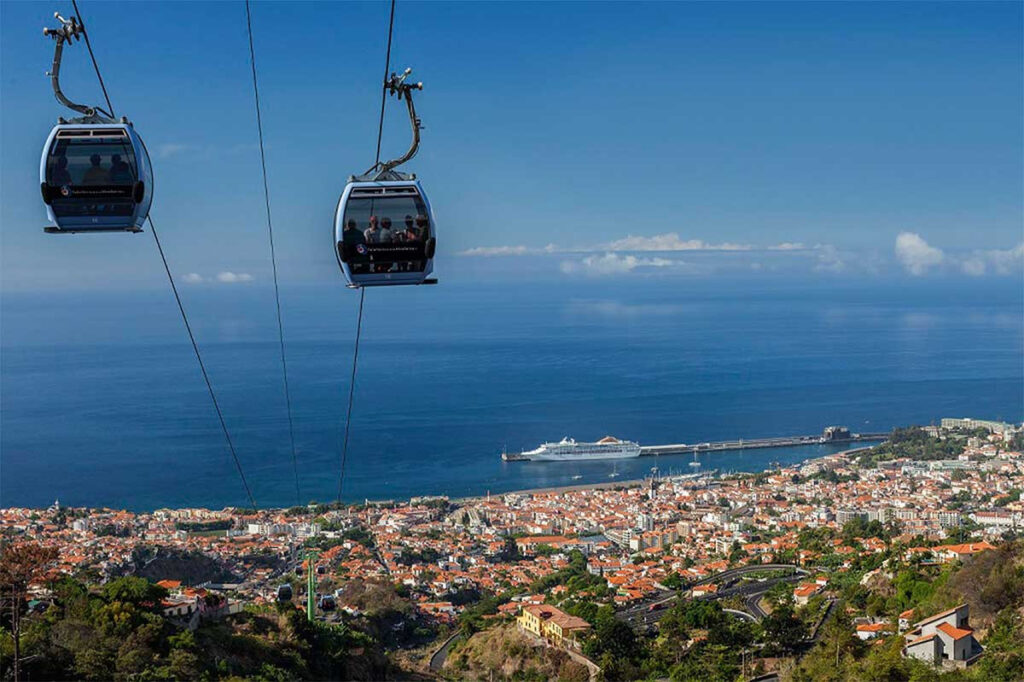
When we arrived back in Funchal, we decided to ride the Monte Cable Car. This ride gives you amazing views of the city and the surrounding landscape. It takes you up to Monte parish, where you can get a bird’s-eye view of Funchal’s terraced hills. A cool thing we learned about the Monte Cable Car was that it was built in 2000, replacing an old railway that was destroyed in a storm in the 1940s. It’s now a popular attraction, providing a scenic route up to Monte, where you can visit the Monte Palace Tropical Garden and the Church of Our Lady of the Monte.
Wednesday in Madeira was packed with amazing views, interesting history, and a good mix of relaxing and adventurous activities. Unfortunately, it was our last day here but we were off to Porto next!
Discovering Porto, Portugal
Porto, Portugal’s second-largest city, is famous for its historic charm, stunning architecture, and port wine. Located along the Douro River, Porto’s historic districts like Ribeira are full of narrow, winding streets and colorful buildings that are picture perfect. There’s so much to see in this beautiful city like the Dom Luís I Bridge for its breathtaking views or Livraria Lello, one of the world’s most beautiful bookstores. You can also take a tour of the port wine cellars in Vila Nova de Gaia, eat some francesinha sandwiches, and maybe hop on a scenic river cruise. Porto’s blend of history, culture, and street life makes it a must-see spot.
Day 4
Flying Out of Madeira
Early Thursday morning, we left Madeira and took a short flight to Porto. Back to gloomy weather, but Porto quickly became my favorite city on this trip. Porto’s architecture is stunning, with a mix of Gothic, Baroque, and Modernist styles. It’s so similar but so different to what we had seen in other parts of portugal. A lot of buildings date back to medieval times, and the famous azulejos—the blue and white tiles—are a huge part of the architecture here.
Tuk-Tuk Tour
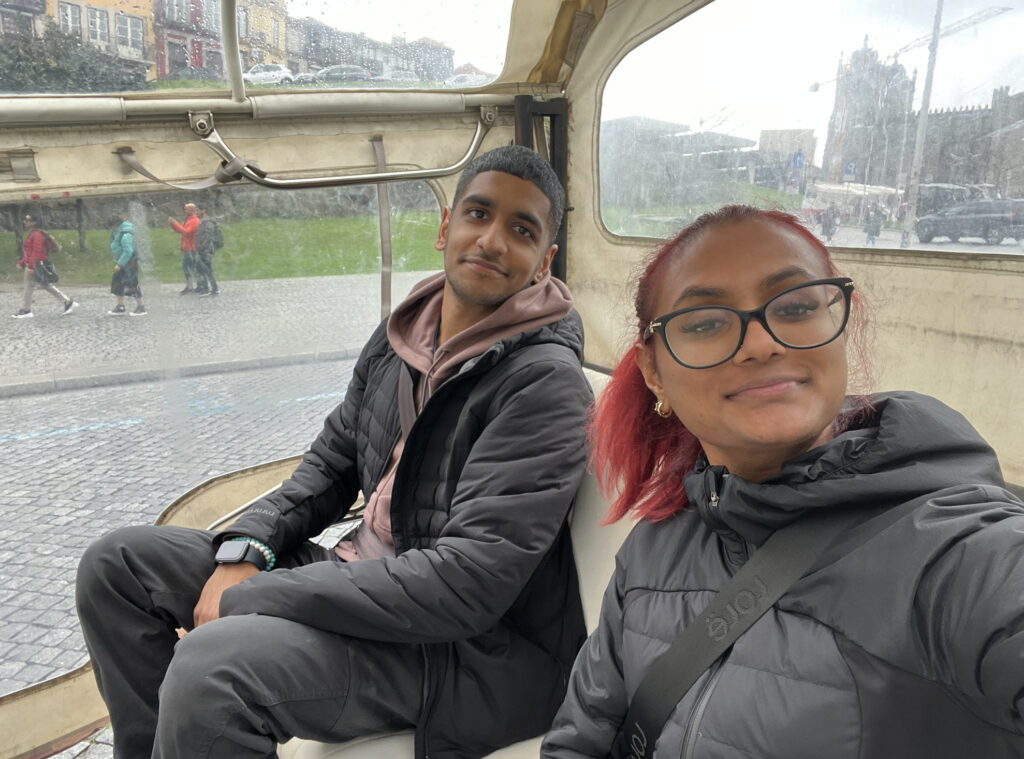
Even though it was a little chilly and wet, we took a tuk-tuk tour to get a feel for the city and its history. I really wanted to know what makes this city so popular. Porto happens to be one of the oldest cities in Europe, with its historic center designated a UNESCO World Heritage Site. Some must-see spots include the Ribeira district, that’s famous for it its narrow, colorful streets; the iconic Dom Luís I Bridge, designed by a disciple of Gustave Eiffel (french civil engineer); and the Clerigos Tower, where you can see panoramic views of the city. The Clerigos Tower was actually the tallest building in Portugal when it was completed in 1763!
Boat Tour of Douro River and Six Bridges

After the tour we went on a boat tour of the Douro River, famous for its six bridges. The Douro River is central to the city’s port wine production. The tour gave us a unique perspective on the Dom Luís I Bridge. Fun fact: it has two levels—one for vehicles and one for pedestrians and the metro.
After the boat tour, we took a cable car up to the top of the Dom Luís I Bridge and walked across it, enjoying roasted chestnuts along the way. The views from the bridge were awesome, giving us a chance to see the river in its entirety.
Imperial McDonald’s

We couldn’t resist checking out the Imperial McDonald’s. This place is known as the most beautiful McDonald’s in the world. They were right! It opened in 1995 in a former café, and the Art Deco design, complete with chandeliers and stained glass windows, is actually so beautiful.
The food was typical for McDonald’s, but eating in such an elegant setting was a truly unique experience. The stained glass windows in this McDonalds were created by artist Ricardo Leone and depict the history of Porto.
St. Francis Church and Catacombs
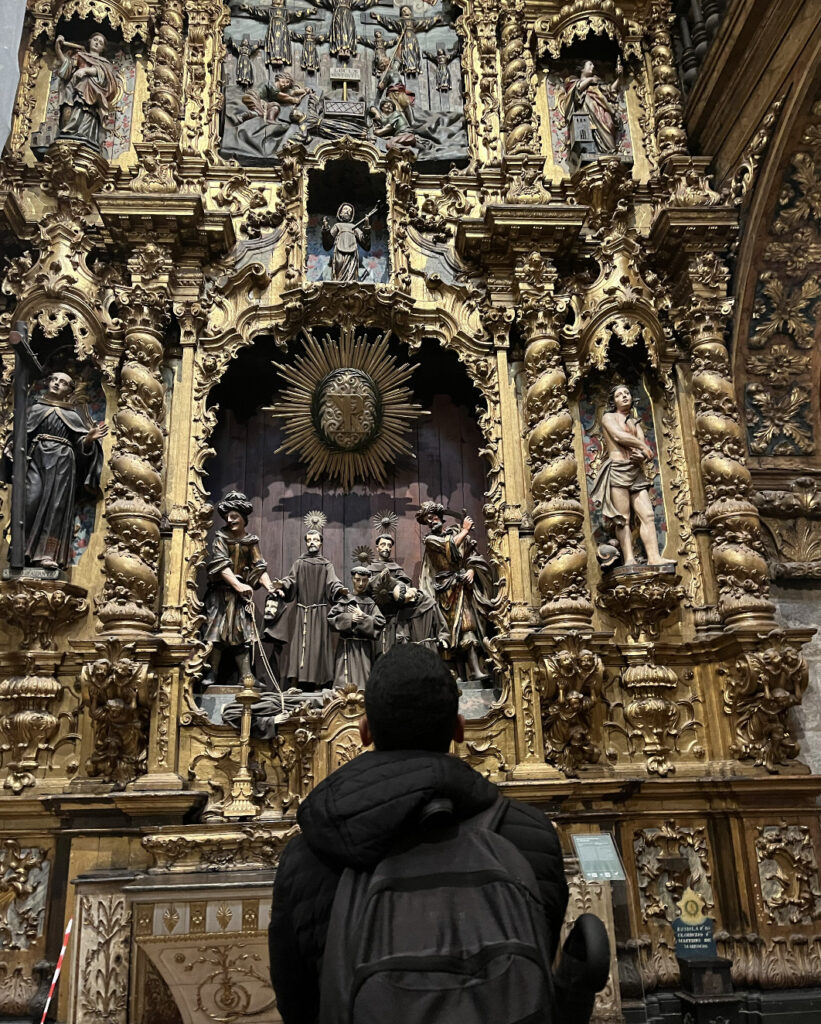
After our little snack, we visited the Church of St. Francis, this church is famous for its Baroque style interior covered in gold leaf. Built in the 14th century, this church is one of Porto’s most important historical sites. The amount of gold used inside is insane—over 300 kilograms! We also had a chance to go into the underground catacombs of the church where monks and noble families were buried. It didn’t help that we went after dark, it was definitely an experience!
Livraria Lello
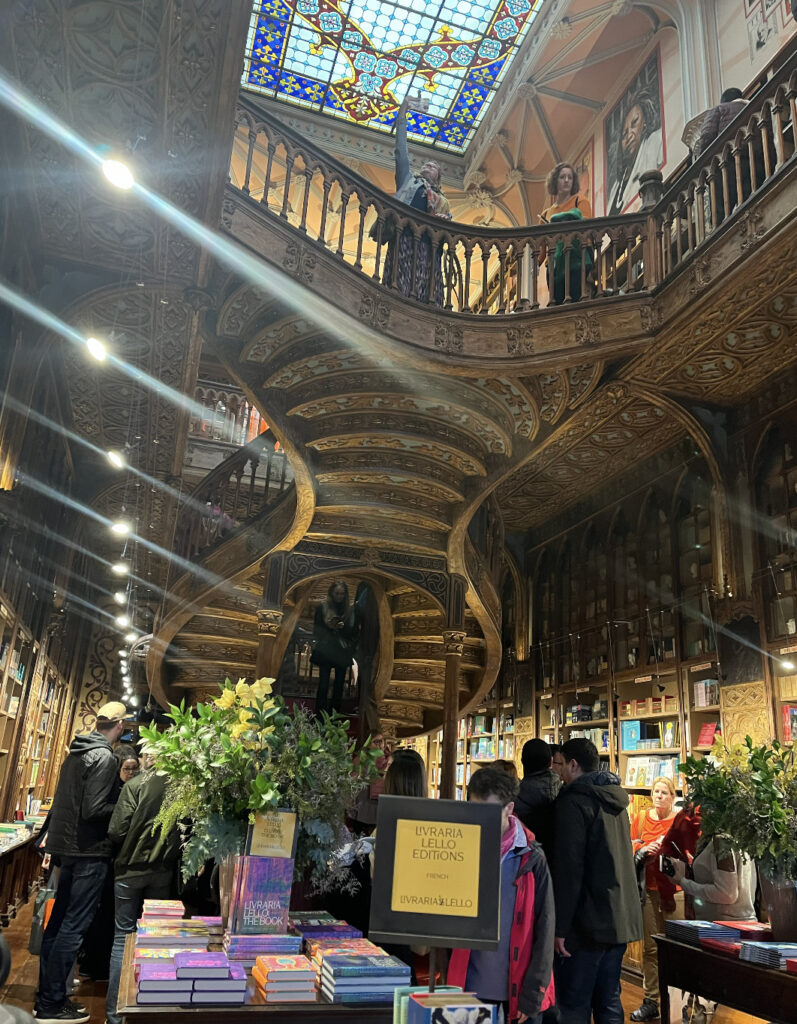
After that spooky experience, we decided to up the vibes a little and head to Livraria Lello, the world’s most beautiful bookstore. Opened in 1906, it showcases stunning Art Nouveau design, with a winding staircase that splits into two, stained glass windows, and detailed woodwork. The bookstore is rumored to have inspired J.K. Rowling when she was writing the early Harry Potter books while living in Porto (we were told this wasn’t true but still a cool thing to have imagined).
Porto Trams
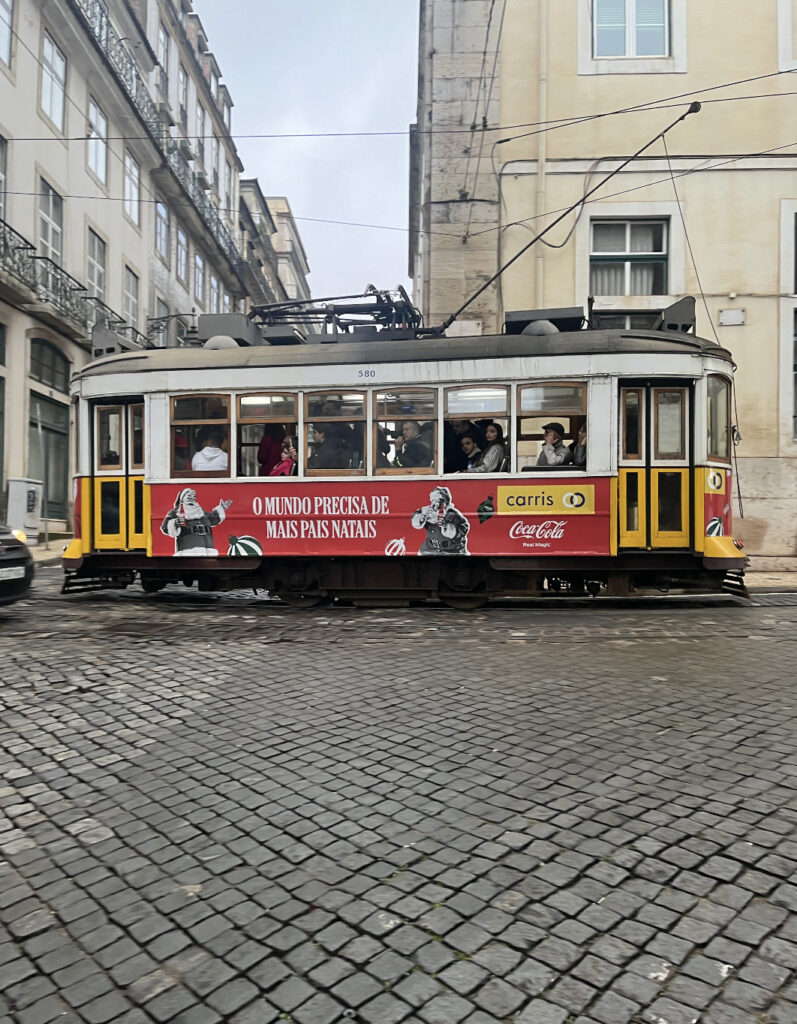
Of course, we couldn’t leave Porto without riding one of its historic trams. Porto’s tram network dates back to 1872, making it one of the oldest in the world. The vintage trams, especially the Route 1 tram that runs along the riverfront, takes you on a scenic route to see the city. A cool thing about the tram system was that it was initially horse-drawn before being electrified in the early 20th century.
Thursday in Porto was packed with history, stunning sights, and unique experiences. Despite the weather, the city’s charm and vibrant culture made it an unforgettable day.
Day 5
Arouca 516 Suspension Bridge

The first thing we did early in the morning was crossing the Arouca 516, one of the longest suspension bridges in the world. Spanning 516 meters across the Paiva Gorge and standing 175 meters above the river, the wobbly bridge gave us crazy views and a huge adrenaline rush. Walking across it was so scary— a mix of excitement and nerves washed over me as we looked down at the river hundreds of feet below. The bridge swayed in the wind, adding to my fear. But the views were absolutely worth it, I was too scared to pull out my phone and take photos thinking I would accidentally drop it but it was an experience to remember.
Paiva Walkways
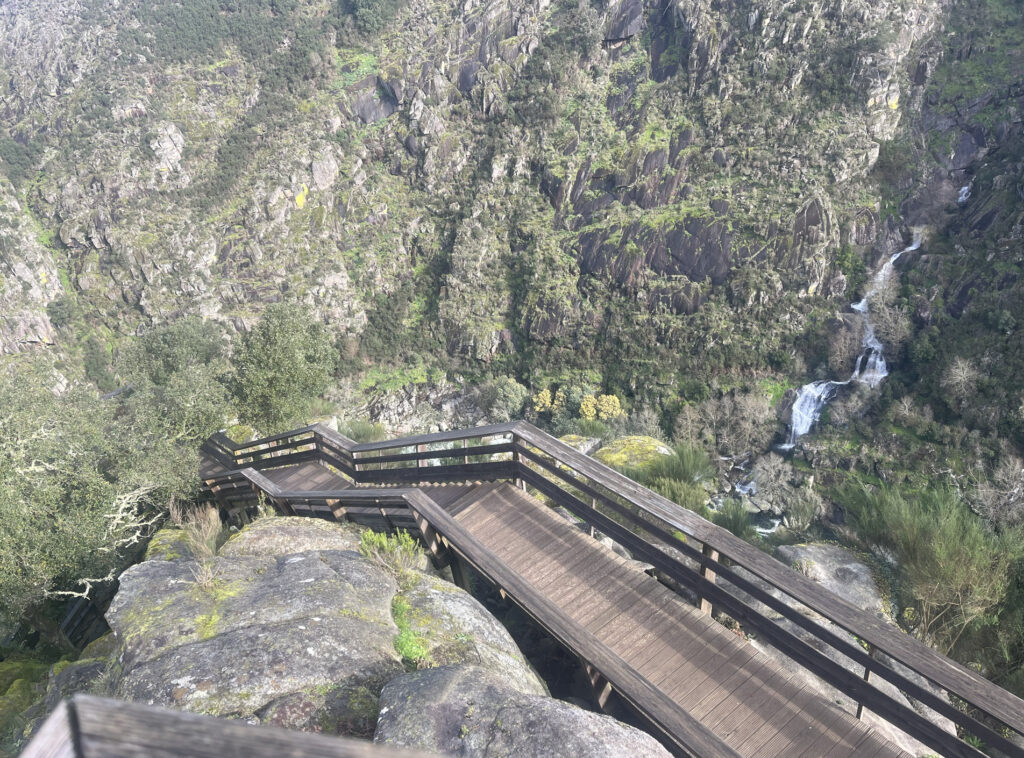
We then headed to start walking along the Paiva Walkways. This 8-kilometer boardwalk winds through the stunning Arouca Geopark, a UNESCO-recognized area known for its landscapes and clear waters. The walkways wind around the river, giving us 360 degree views of the greenery and the crystal-clear Paiva River below. It felt like we were walking through a scene from a nature documentary. The fresh air and the sound of the flowing river made for a perfect start to the day. It was peaceful and everyone walked in silence making us feel so connected to the nature around us.
Traditional Countryside Meal
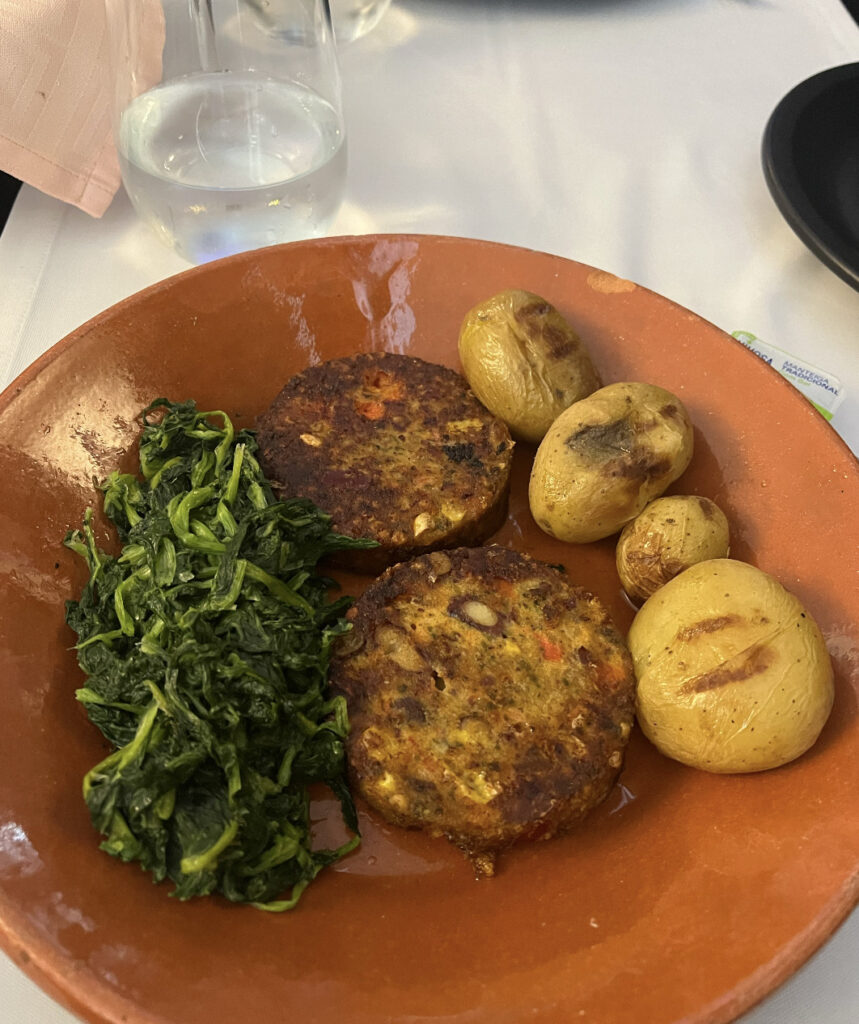
After that long walk and working up an appetite, we were taken to a traditional countryside restaurant for some veal. I opted for the vegetarian meal with some fresh roasted potatoes and spinach. It was amazing! Some of the best food I’ve had since we got to portugal. The atmosphere of this small restaurant was warm and cozy, and felt like we were at someone’s house eating a home-cooked meal. It was a comforting and satisfying meal, perfect for recharging.
Discovering Aveiro
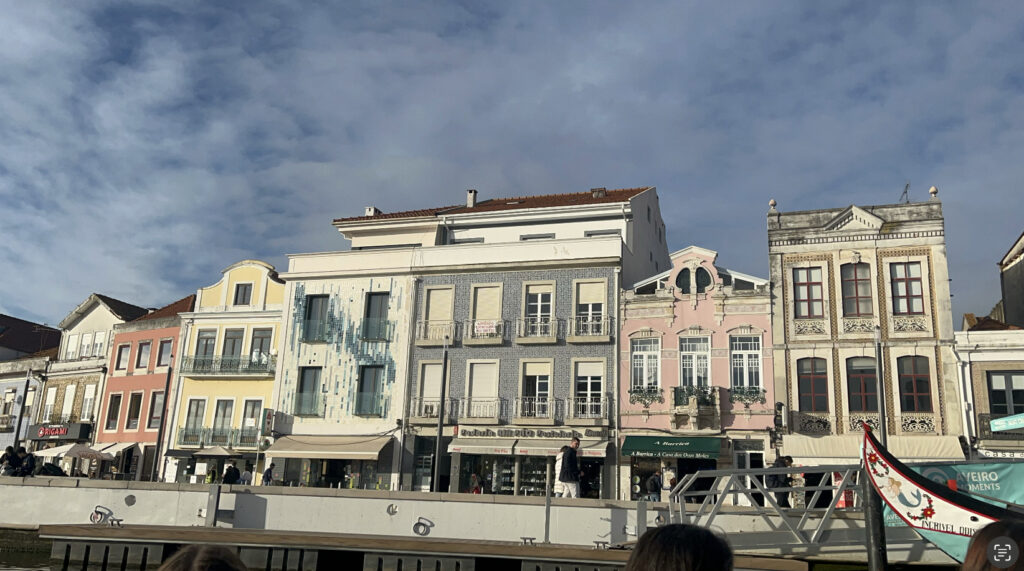
Next, we headed to Aveiro, also called the Portuguese Venice because of its canals and colorful boats “moliceiros”. The boat ride through the canals was a highlight. The boats are beautifully painted (sometimes with funny sexual references) giving us a unique view of the city’s Art Nouveau buildings and street life. The ride was relaxing and fun, and the guides shared interesting facts about the city’s history. We loved seeing the locals going about their day.
Visit to Costa Nova
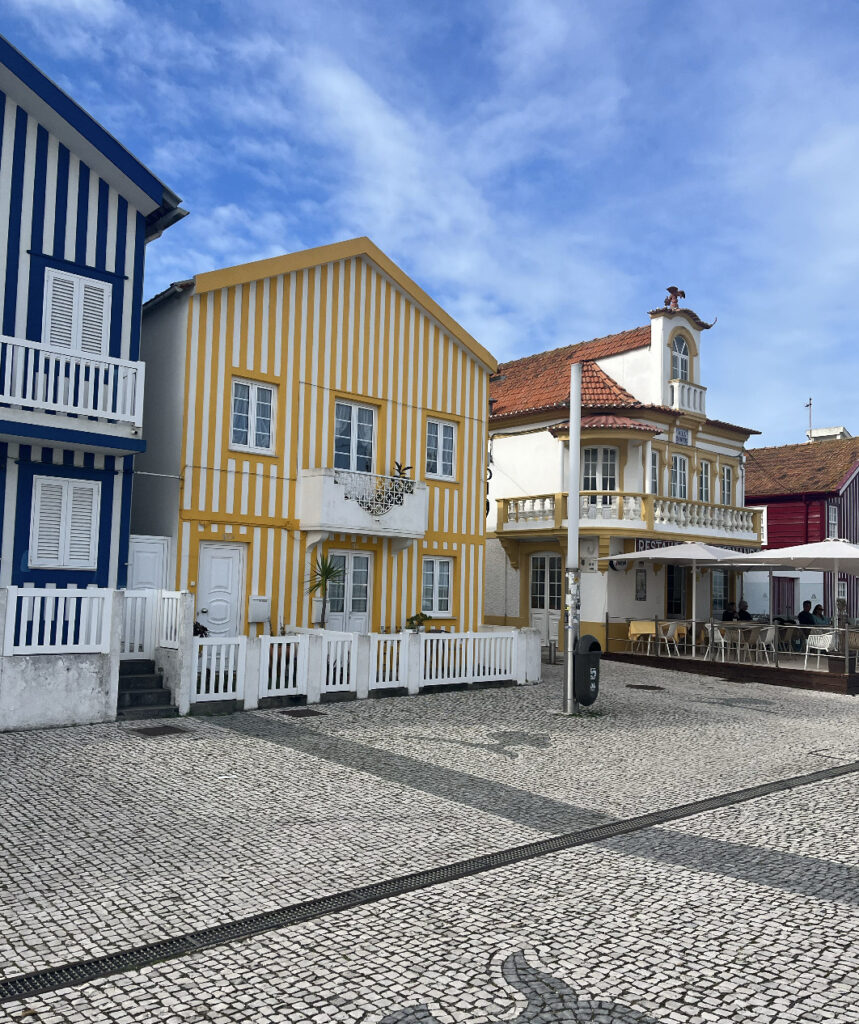
Our final stop was Costa Nova, a coastal town famous for its brightly colored striped houses. Walking along the beach and seeing these cheerful, candy-striped houses was so surreal. It felt like we were in a storybook and Goldilocks was about to walk out of one of the houses. We walked around, tried some pastries, took lots of photos, and relaxed in the laid-back vibe of the town. The smell of the ocean and the sound of the waves made it a calming experience. It was the perfect end to our day trip.
Day 6
Train Ride Back to Lisbon
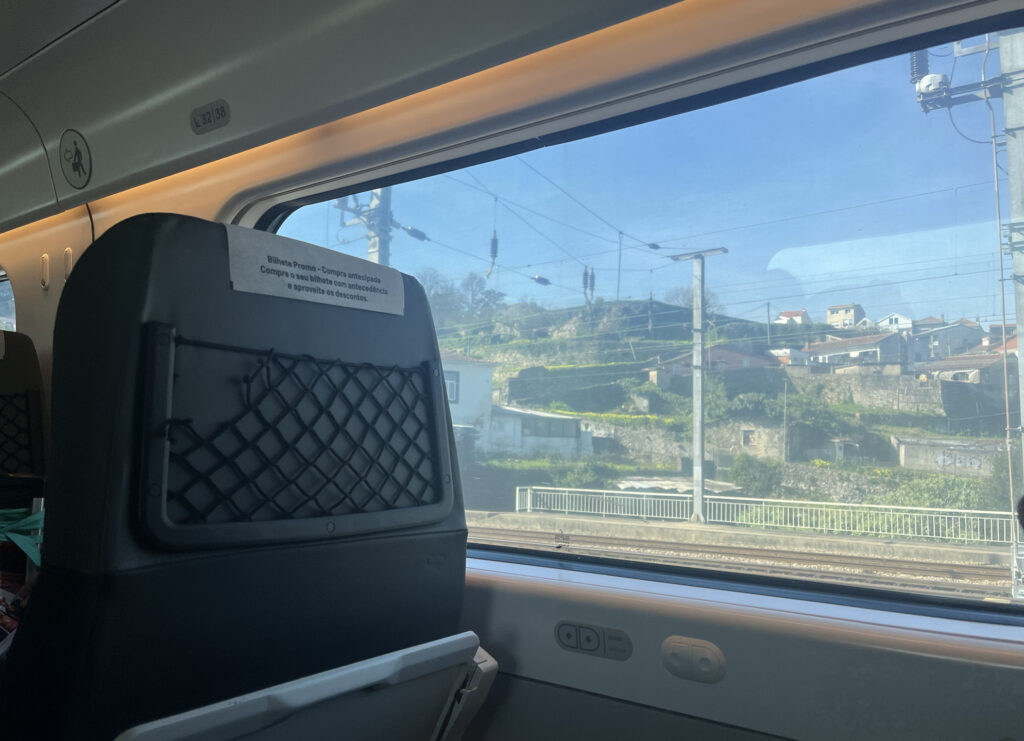
Saturday morning, we hopped on a local train back to Lisbon. We picked up some fresh fruit from a vendor before boarding—some grapes and strawberries that were perfect for the trip. We spent half the journey napping and snacking on the train. It was nice to relax a bit after our busy week, and watching the Portuguese countryside roll by was pretty epic.
Exploring Lisbon Again
When we arrived in Lisbon, our first stop was, of course, to get more pastel de nata. Seriously, these pastries are like little bites of heaven. After eating like four more, we set out to explore the city one last time.
More Exciting Places

While we were walking around we stumbled upon Livraria Bertrand, a cute little bookshop that claims to be the oldest operating bookstore in the world, dating back to 1732! The place had an incredible collection of books, both Portuguese and international. We browsed around and checked out some of the old books before heading out.

Next, we went to Miradouro de Santa Catarina, a viewpoint that showed the stunning views of the Tagus River and the 25 de Abril Bridge. The area around the viewpoint was full of so much energy—street musicians, couples watching the sunset, and kids running around. We found a spot on the wall, sat down, and just people watched. It was one of those perfect travel moments.
Last-Minute Shopping
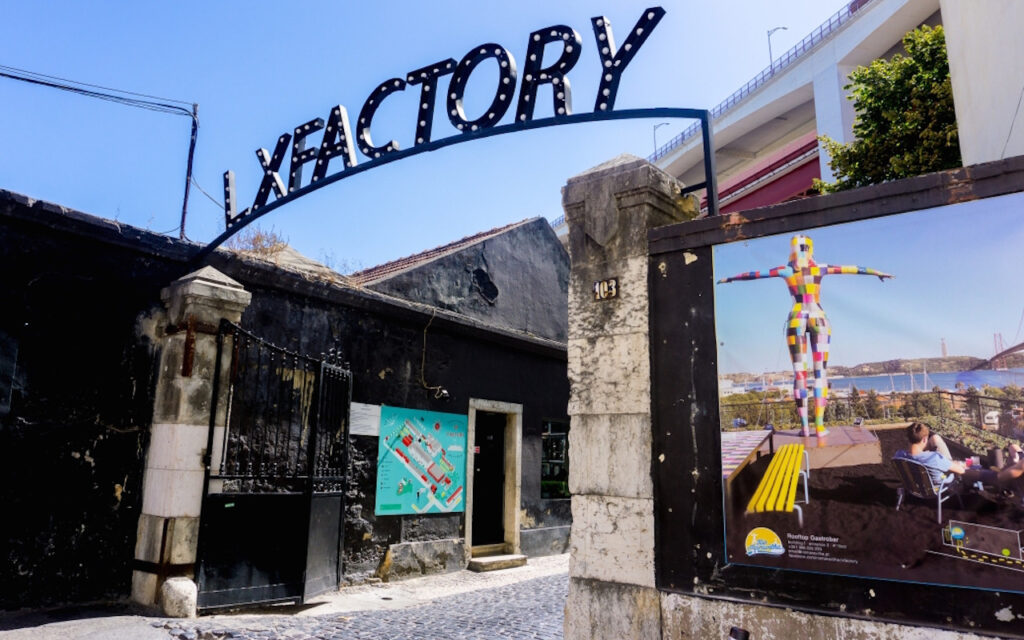
Before heading back to dinner we also checked out LX Factory, a quirky market located in a converted industrial complex. The place was also so full of life, unique shops, cafes, and art installations. We picked up a few souvenirs, including some funky handmade jewelry and artisanal chocolates. We also grabbed a coffee at one of the trendy cafes. The vibe was so cool and creative—it felt like we were in the heart of Lisbon’s artsy scene.
Farewell Dinner

For our final meal, we found a little restaurant in the Alfama district. The narrow, winding streets and historic buildings gave the area an, old-world feel. The restaurant itself was small and intimate, with candlelit tables and traditional Portuguese tiles on the walls. We ordered some traditional Portuguese dishes like caldo verde (a delicious green soup) and piri-piri chicken. The food was incredible, and the atmosphere was warm and welcoming.
Saturday was the perfect way to wrap up our trip, with a mix of relaxation, exploration, and, of course, incredible food. We left Lisbon feeling both exhilarated and content, already dreaming of our next adventure.
Wrapping up
Our trip to Portugal was truly unforgettable. We loved every moment, from exploring the historic streets of Lisbon and the fairytale-like Pena Palace in Sintra to soaking in the breathtaking views in Madeira and enjoying the vibrant culture in Porto. There’s so much we didn’t get to see, like the salt pans of Aveiro and some of the hikes. We’re already planning our next visit to catch everything we missed. Portugal, we’ll definitely be back! It was bittersweet knowing our adventure was ending, but we were grateful for all the amazing experiences we had.
For learn more about Portugal check out Trevor’s guide to Porto!
How did you find such cheap flights to Portugal?
Use local transportation like trains and Bolt rides (Madeira doesn’t use bolt as much so be weary of that), stay in hostels or family-run guesthouses, and eat at markets or cafés where locals go. Booking flights through deal sites like YYZdeals or Skyscanner can save you hundreds.
How many days do you really need to enjoy Portugal without rushing?
Ten to twelve days is ideal. That gives you time for Lisbon, a day trip to Sintra, three days in Madeira, and two or three in Porto. Anything less feels rushed, especially with flight and travel times. I know we felt a bit rushed.
hat’s the easiest way to travel between Lisbon and Porto?
Take the Alfa Pendular train. It’s fast, scenic, and much cheaper than flying. Book early on the Comboios de Portugal website for discounted fares.
How expensive is Portugal compared to other European destinations?
Portugal is one of the most affordable countries in Western Europe. Meals at local cafés range from 8–12 euros, hostels start around 20–25 euros, and train tickets are reasonably priced.
Is it worth visiting Madeira on the same trip as Lisbon and Porto?
Yes, if you can add at least three full days. Madeira feels completely different from the mainland. It’s perfect for travelers who love nature, hiking, and coastal views. It’s also easy to reach with short flights from Lisbon. It was literally my favourite part of the trip.
What’s one thing travelers often overlook in Portugal?
The viewpoints, or “miradouros.” Every city has several, and they’re free. Locals gather there at sunset with snacks or drinks. It’s the easiest way to experience Portugal like a local.

